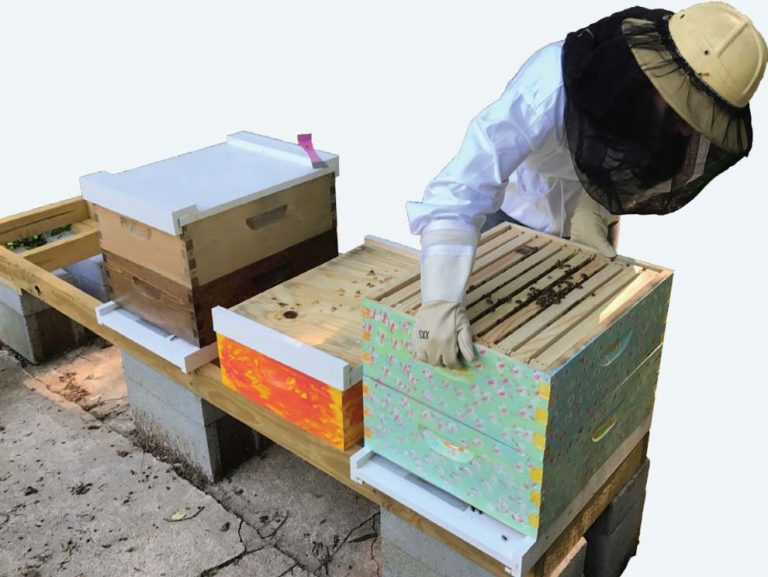
Taylor Krebsbach’s first experiment with raising her own food didn’t go smoothly.
Krebsbach, a consultant and reserving specialist with FTI Consulting in Winston-Salem, had bought 10 fluffy yellow chicks to join the six ducks in her backyard barn. There was just one problem with her plan: It’s impossible to tell if a baby chicken will turn into a hen or a rooster. She took a trip a few months later, but unbeknownst to her, the animals were about to hit chicken puberty. “I came home from vacation,” Krebsbach says, “and I had three roosters crowing. I had to text my neighbors and say, ‘I’m so sorry.’” She quickly traded the roosters for hens using Craigslist, and her neighbors got to sleep undisturbed again.
The mishap didn’t stop Krebsbach from adding a completely new animal to her yard this year: bees.
Krebsbach got hooked on bees when she was a little girl. Her aunt, a long-time beekeeper, introduced her to the insects. “She would always teach me about their behavior, and how they know how to do certain things. I just thought it was really fascinating,” says Krebsbach.
It wasn’t until Krebsbach moved south, from Massachusetts to North Carolina, that she had both the warm weather and the big backyard that she wanted. So in January, she and her boyfriend, Cody Davis, took the next step together, enrolling in a class offered by the Forsyth County Beekeepers Association. “Whenever I would tell people I was going to bee school,” Krebsbach says, “they’d say, ‘oh, you’re going to business school?’ And I was like, no, bee school!” At the end of the course, Krebsbach passed a written and practical test to become a certified beekeeper.
In April she and Davis each purchased a hive nucleus, a small bee colony equipped with a queen bee, from a beekeeping neighbor. Their colonies contain Russian bees, a strain of honeybee (Apis mellifera) imported from the Pacific coast of Russia by the USDA in 1997. Unlike many other honeybee strains, Russian bees are nearly immune to the mites that have driven massive die-offs in bees in recent years. “They’ll actually eat mites off each other,” says Krebsbach.
Twice a month, Krebsbach puts on a special outfit — khaki pants, gloves and a white hooded sweatshirt with a built-in screen that protects her face. Then she uses pine shavings to light a fire in a handheld smoker, a beekeeper’s tool that gives off a continuous stream of cool smoke. When bees smell the smoke, they instinctively react as if a forest fire is nearby that might destroy their hive. They move deep into the hive and begin eating their supply of honey, in case they have to abandon it. While the bees are busy eating, Krebsbach can carry out the routine task of inspecting her hive.
One by one, Krebsbach pulls out each frame, or individual box, in the hive. She checks on how the hive is growing and how much honey the bees have stored. She also looks closely at how many eggs the queen bee has laid. Since worker bee eggs take 21 days to hatch, moving through three visibly different stages — egg, larva and pupa — Krebsbach can judge how many new bees are about to join the hive.
“Say you have two frames full of pupae,” she explains. “You’re going to have an explosion of bees, and you need to support them. If the beekeeper fails to enlarge the hive by adding more frames,” Krebsbach says, “the bees run out of room, and will swarm. When that happens, the queen bee, along with 60 percent of the worker bees, flies off to find a new home, leaving the beekeeper with a much smaller hive.”
Although beekeepers only formally inspect their hives twice a month, Krebsbach frequently drops by her colony just to watch her bees going about their business. “My boyfriend will put a lawn chair next to the hive and watch them for like, an hour,” she says, “because it’s pretty entertaining.”

Even though her hive and her boyfriend’s hive sit just a few feet apart, it’s strictly a “his” and “hers” arrangement, with no cooperation between the hives. “My bees will not go into his hive, and his bees will not go into my hive. They know where they live, and they will return there, which is really fascinating.” Designated bees guard the entrance to each hive to keep intruders out.
When Krebsbach bought her bees, she was afraid of getting stung. Ironically, she lost that fear after a bee clocked her, right on the forehead. At the time, Krebsbach wasn’t wearing her protective gear or carrying her smoker, a key safety tool in case of a sting.
“Bees are very, very smell driven,” Krebsbach says. “And when they sting you, they release a pheromone, which says, ‘this is a bad person, they’re invading our space.’ And so all the bees around there will smell that, and they’ll attack you. The smoker will make that signal fade really quickly.” Since she didn’t have a smoker, Krebsbach just ran into her house at top speed. In hindsight, “it really wasn’t that bad,” she says, “and it got that fear to go away.”
As a first-year beekeeper, Krebsbach won’t be reaping the usual reward from her hive in the form of honey. Bees stockpile honey so they have something to eat during the winter months. “You have to leave a certain amount of honey in the hive, so they have enough food to last the winter,” says Krebsbach. “So I don’t think we’ll be taking from our hives this year, just because we don’t want them to die. We’re new at this.”
She may not have beeswax or glowing jars of honey to show for her work this year, but Krebsbach feels she’s already received other rewards. She likes knowing she’s helping the environment. The bees also pollinate the plants in her extensive garden, where she grows everything from onions to watermelons to herbs. Before she went to bee school, Krebsbach says, “I didn’t realize that one onion plant had to be visited a handful of times to produce an onion. One onion. So we need bees!”
Krebsbach also has her eyes on the future. “Next year we’ll have enough [honey] to sell,” she says. “That’s the plan. It would be cool to have a place at the farmers’ market with our honey and eggs.”
Krebsbach wants to encourage more people to take up beekeeping. It costs about $300 to $500 to purchase equipment and bees, but after that, she says, “it’s a low-maintenance hobby. Everyone I talk to about it thinks it’s so fascinating. I tell them, ‘You can do it, too! It’s really easy.’”
Laurie McClellan is a freelance writer and photographer living in Arlington, Virginia. She is on the faculty of Johns Hopkins University, where she teaches in the M.A. in Science Writing program.
Buzzwords
Have you ever heard of a “corporate drone” or a “worker bee?” Here’s the real science behind the workplace metaphors.
Worker bee: It’s true that worker bees are remarkably industrious. The cause of death for the average worker bee? Wearing out its wings on the job. Bees beat their wings 190 times every second, which creates their distinctive buzzing sound. All worker bees are female, and the average hive has 10,000 to 50,000 of them. The lifetime output of a worker bee is 1/12 of a teaspoon of honey.
Drone: According to Webster’s Dictionary, a drone is someone who does “very hard or dull work.” Not so in the beehive! Real drones live a relatively cushy life. The only job of these male bees is to mate with a new queen when needed. However, many drones never get the chance to fulfill their biological destiny; instead, they simply hang around the hive and eat.
Queen bee: A single leader is sometimes called a “queen bee,” which is an accurate reflection of what goes on in the hive. Each beehive can have only one queen. If several queens hatch when the hive is getting established, the queens will fight to the death, until only the winner is left. Her Royal Highness is responsible for laying all the eggs that will hatch into future bees.
Honeycomb: Like the office cubicle, the honeycomb that bees construct is a way to fit more workers into less space. Each cell of a honeycomb, which is used to store larvae as well as honey and pollen, has six sides. In 1999 mathematician Thomas Hales proved the honeycomb conjecture, which holds that this shape — the hexagon — is the most efficient way to pack a space.











